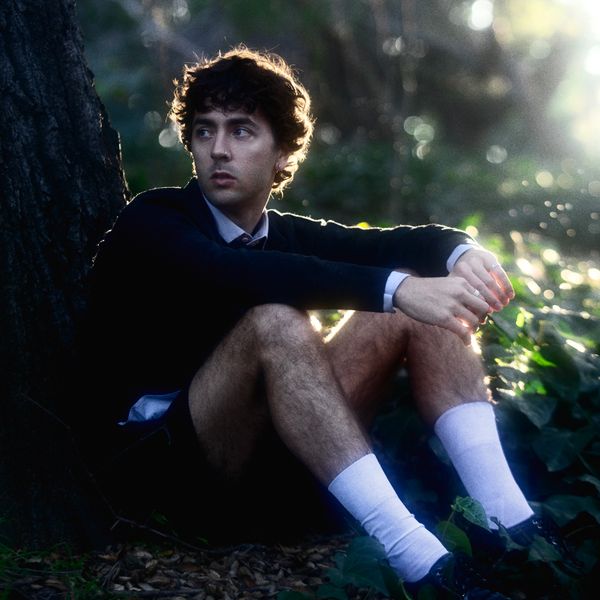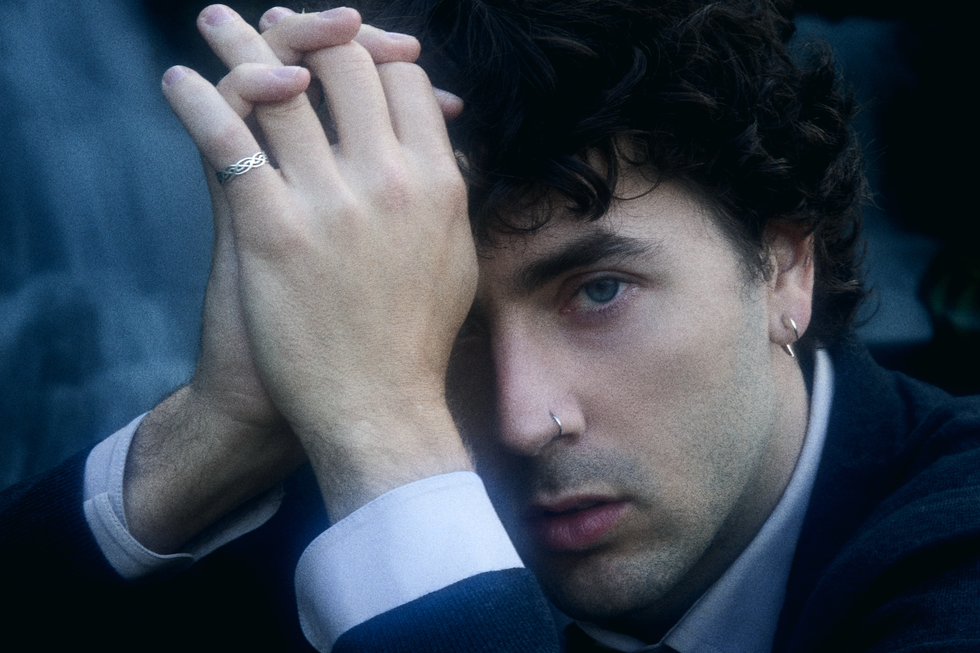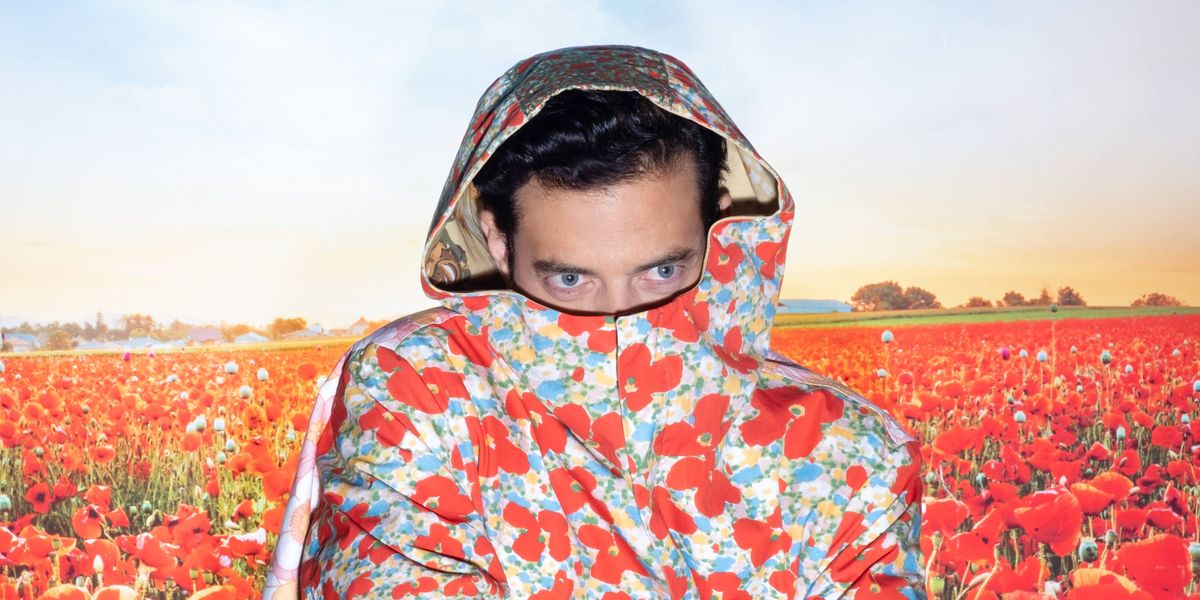
Casey MQ Can’t Stop Interrogating Memory
By Matt Wille
Jun 07, 2024Casey MQ is booked and busy — but somehow he did manage to read the entirety of Proust’s In Search of Lost Time last year.
“I’d read bits and pieces before making the album, but once it was written I knew I was ready to read it. It gave the album a new context while I was mixing it,” Casey tells PAPER. “A new perspective on memory itself, really.”
Memory is important function of Casey’s latest album, Later that day, the day before, or the day before that, a guiding principle that really sets is apart from his debut, 2020’s babycasey. While finishing that album, Casey found himself reflecting on the process of recreating one’s childhood, of the malleability of remembering and forgetting. “I wanted to make an album that looked at all the different ways we interact with memory itself, and remembering, and, more importantly, forgetting — where it goes and where it disappears to is as important as the memory itself,” he says.
Hence the new album’s title, which reminds listeners that nothing we remember is concrete. Was it actually later that day, or was it the day before... or what is the day before that? Sonically, the album is a significant departure from babycasey (and especially from its companion, the hyperpop-influenced babycasey ultra), centering itself on piano and vocals. Also mostly absent from Later that day... is the heavy collaboration Casey’s utilized in the past. The throughline here, besides, Casey himself, is the production, which follows from Casey’s more electronic roots.
Ahead of the release of Later that day..., PAPER caught up with Casey MQ to discuss the album-making process, Buffy the Vampire Slayer and, of course, the nature of memory itself.
How are you feeling about the album, now that it’s almost here?
I’m feeling great, now that the three singles are out. The intro to the story has been told, now people can be immersed in the album. I’m just excited for everyone to hear the full body and get the entire picture.
I know you’ve been calling this a “memory album.” What do you mean by that?
Well, babycasey was kind of a memory album in its concept, too, in the sense that I was trying to retell my childhood, to recreate it from the perspective of a child and interrogate ideas I may have had as a kid. And looking back on things gave me this new lens with how I’m interacting with life — I had this realization about what it means to be in the present and what it means to look back and where the actual things we do in our life go. Because it’s so elusive, it opened up this catharsis for me. There was just so much to draw from, and there still is so much to draw from. I wanted to make an album that looked at all the different ways we interact with memory itself, and remembering, and, more importantly, forgetting — where it goes and where it disappears to is as important as the memory itself.
That’s so interesting. I actually wrote my thesis on similar concepts, and specifically on temporality in Frankenstein and Buffy the Vampire Slayer.
Oh my god, I definitely need to read that.
I saw you saying in another interview that you’ve been reading In Search of Lost Time.
Oh yeah, I finished it. Crazy.
Did that contribute to how you were thinking about this album?
Oh, 100%. I did a lot of reading and talked to a lot of friends about the topic of memory and time, I was reading shorter-form stuff, mostly. A lot of films. I’d read bits and pieces of In Search of Lost Time during the album-making process, and once the album was written, I was like, “I should probably read this now, now I’m ready.” I read it over the course of this last year while I was finishing production and mixing and mastering. I’d start my day by reading it. It gave me new context for the album — like, oh, wait, I need to talk more about this, I need to dig more into that. It’s given me new perspective on memory.

Do you recommend it?
Definitely, if you’re down for a long one. When I first started it, there were friends on board to read it with me — they were like, “Hell yeah, we’re gonna read this!” — and then they were dropping one by one.
You should read Karl Ove Knausgaard.
I’m trying to remember what else I was reading at the time. I would get sent like, essays from Freud.
It sounds like a very scholarly album-making process.
Oh, yeah, I was getting into it. My ex happened to be pretty in this world, I love talking to him about it. I have all these PDFs on my desktop., still. I just really wanted to get new influences and see what the possibilities would be. I wanted to challenge myself. I didn’t go to university or anything.
How does the album title tie into those ideas?
There were lots of titles floating around in my head. At some point, I’d just written that down in my notebook, not even as a title idea, just some words, maybe a lyric or something. And then when I was getting ready to name the album, I realized that line worked so well: Later that day, the day before that — I’m even messing up the syntax now. I was like: that’s what it is. I can just imagine someone trying to recommend it and messing it up, too. And I think when you listen to the album, it connects the dots to that motivation. It goes into that abstraction, you know what I mean? I wanted things to linger, to be haunting. “Haunting” is an important word. And not necessarily with negative connotations. Beautiful, spiritual… what returns out of nowhere and maybe has a shock element to it. But how does it come back?
What was the album-making process like for you this time around?
It really started with a feeling for me. I knew I wanted to create a piano album. I didn’t know in what form it would take, but I wanted piano to be one of the main voices on the album. I felt this urge to return back to piano in my life in a new way, with an urgency that I hadn’t felt before. I mean, I love pop music, I love electronic music. I’m actually on my way to play a set for Club Shygirl after this call.
Oh, I saw her last week, it was incredible.
So that’s still a big part of my life. But I needed to go back to this, to the piano, to conversate with it again, with a part of my life that’s always been there. I wanted a big part of the writing to be on the piano. And then the electronic element of the album gave shape to the album, too.
Ultimately, I wanted to make something that would comfort me, that would put me at ease and take me into a mode of reflection and contemplation and would allow me the space to do that.
Would you say you were successful in doing that?
Yes, for me it’s successful. It’s one of the first time I’ve made an album that I love listening to. I needed something to hold me, something I could put on while I’m on the train and enjoy listening to it. And ultimately — that seems like such an obvious goal — but it’s what I needed.

Both babycasey and babycasey ultra were very collaborative works — was there much collaboration on this project?
The first half of making it was very solo. I was living in Toronto at the time and made a lot of the album there. And then, at some point, I decided to move to LA, and I started to work with Cecile Believe on a few songs on the album.
Oh, big fan, I saw her in Montreal when she was still Mozart’s Sister.
Oh, I love that. Yeah, she worked on a few of the songs, and we also just talked about the album and had amazing conversations about our respective works that really put things in perspective for me.
But then the second half was mostly alone, too. With the help of some friends along the way type of thing. babycasey and ultra were sort of the opposite, yeah, with a full cast of amazing artists and sounds that were very expansive. This one was going internal, I guess.
One more question — what are you listening to these days?
I just got back from Hawaii, I went with some amazing artists, just making music and having a little trip together. We made this Hawaii playlist that was a lot of ‘70s rock and folk.
Oh, and I’m always listening to Boards of Canada, of course.
Photography: Jason Al-Taan
MORE ON PAPER
Entertainment
Rami Malek Is Certifiably Unserious
Story by Joan Summers / Photography by Adam Powell
Story by Joan Summers / Photography by Adam Powell
14 November
Music
Janelle Monáe, HalloQueen
Story by Ivan Guzman / Photography by Pol Kurucz/ Styling by Alexandra Mandelkorn/ Hair by Nikki Nelms/ Makeup by Sasha Glasser/ Nails by Juan Alvear/ Set design by Krystall Schott
Story by Ivan Guzman / Photography by Pol Kurucz/ Styling by Alexandra Mandelkorn/ Hair by Nikki Nelms/ Makeup by Sasha Glasser/ Nails by Juan Alvear/ Set design by Krystall Schott
27 October
Music
You Don’t Move Cardi B
Story by Erica Campbell / Photography by Jora Frantzis / Styling by Kollin Carter/ Hair by Tokyo Stylez/ Makeup by Erika LaPearl/ Nails by Coca Nguyen/ Set design by Allegra Peyton
Story by Erica Campbell / Photography by Jora Frantzis / Styling by Kollin Carter/ Hair by Tokyo Stylez/ Makeup by Erika LaPearl/ Nails by Coca Nguyen/ Set design by Allegra Peyton
14 October
Entertainment
Matthew McConaughey Found His Rhythm
Story by Joan Summers / Photography by Greg Swales / Styling by Angelina Cantu / Grooming by Kara Yoshimoto Bua
Story by Joan Summers / Photography by Greg Swales / Styling by Angelina Cantu / Grooming by Kara Yoshimoto Bua
30 September
Music
Demi Lovato Is No Joke
Story by Ivan Guzman / Photography by Jason Renaud / Styling by Chris Horan/ Makeup by Loftjet / Set design by Allegra Peyton
Story by Ivan Guzman / Photography by Jason Renaud / Styling by Chris Horan/ Makeup by Loftjet / Set design by Allegra Peyton
15 September




